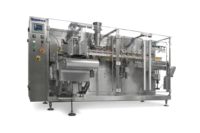Ready-To-Eat Revs Up
By Richard Mitchell, Editor
Newer flavors and a demand for convenience are bolstering consumer interest in refrigerated heat-and-serve entrées.
Supermarket meat departments are going through an evolution. While still dominated by fresh products, the sections are increasingly displaying a wider variety of refrigerated heat-and-serve entrées as retailers and producers respond to consumers’ demand for convenience.
The National Meat Case Study 2004, for instance, noted that 87 percent of supermarkets surveyed carried ready-to-eat/heat-and-serve products, and that heat-and-serve’s share of the total linear feet in the meat department increased 2 percent from 2002.
Fresh meat and poultry’s share, meanwhile, declined from 69 percent to 63 percent as gains also were registered by processed meats (2 percentage points), and ready-to-cook value-added products and self-serve seafood (1 percentage point each).
“The heat-and-serve entrée category has been around for 15 years, but only in the last five has it begun to take traction with the consumer,” says Kim Barden, brand manager of the Flavoré line of heat-and-serve products for Morton, IL-based RMH Foods, a division of Smithfield Foods. “Fewer people are cooking from scratch anymore, and we will begin to reach critical mass over the next decade.”
The study — sponsored by the Duncan, SC-based Cryovac Food Packaging Division of Sealed Air Corp., the Clive, IA-based National Pork Board, and America’s Beef Producers through the Beef Checkoff Program — also revealed that 82 percent of the supermarkets merchandised heat-and-serve products with value-added items to create one location for convenience foods. The study audited 104 retail stores in 43 key metro areas across 29 states. Information was derived from more than 117,000 packages.
The value-added category, meanwhile, which includes ready-to-eat products, also is gaining popularity. Sales in the sector were up 1.7 percent for the 52-week period ending July 3, 2005, according to FreshLook Marketing Group LLC, a Hoffman Estates, IL-based provider of scanner-based sales data on perishable products. Other items in the category are fixed-weight dinner entrées; ready-to-cook items that have been seasoned, marinated, or stuffed; and specialty cut products such as stew meat and strips for stir fry. Value-added foods represent about 7 percent of total meat-case sales and 5 percent of pounds sold, FreshLook notes.
Chicken accounts for 8.9 percent of meat-case sales of the value-added proteins, followed by pork at 8.1 percent, and beef at 6.7 percent. Value-added beef comprises 6.5 percent of pounds sold at the meat case, while value-added pork has a 5.1-percent share, and chicken a 4.4-percent share, FreshLook reports.
Greater consumer interest in refrigerated heat-and-serve entrées is being fueled by both a desire for convenience and the rollout of additional products. The Flavoré line, for example, features 10 varieties of meals including two new items that were released in September: a Jambalaya composed of ham, chicken breast, and Cajun-style smoked sausage and served on a bed of white rice; and Thai Pork with rice.
Best-selling items include Beef Burgundy and Island Grilled Chicken, a Caribbean-style poultry. Flavoré packages contain two servings and can be prepared in less than six minutes, Barden says. Each product consists of two pouches: one holds the meat and sauce, and the second either rice or pasta.
Families with household incomes of more than $60,000 are the primary buyers of the heat-and-serve products, he notes. Among the core consumer segments are empty-nesters, families with older children, and young couples.
“The target customer is a heavy user of convenience foods, but it still is essential to provide those shoppers with products that have great taste and culinary integrity in order to develop repeat and brand-loyal customers,” Barden says.
Also adding to the array of easy-to-prepare entrees is ConAgra Foods Inc., which recently released four new dinners under its Healthy Choice brand: Sweet Bourbon Steak, Grilled Chicken Monterey, Grilled Chicken with Honey Balsamic Sauce, and Fiesta Chicken.
The 78 Healthy Choice dinners are being promoted by Healthy Choice’s new nationwide consumer marketing campaign that was launched in August. Using the theme “Green Is Good” because of the brand’s green packaging, the initiative features television advertising, in-store programs including the use of shelf talkers and coupon machines, and free-standing inserts in local newspapers. ConAgra reports that the campaign was tested in three markets this spring and generated a significant lift in sales.
“We’re developing contemporary foods that fit a more sophisticated palate,” says Bill Partyka, vice president of marketing for Omaha-based Healthy Choice.
Other Healthy Choice products being publicized in the marketing include Deluxe Thin-Sliced tub lunchmeats which are available in four flavors, and four selections of sliced bread, soups, and sauces.
Richard Mitchell is editor of Stagnito’s Meat & Deli Retailer magazine.




Report Abusive Comment